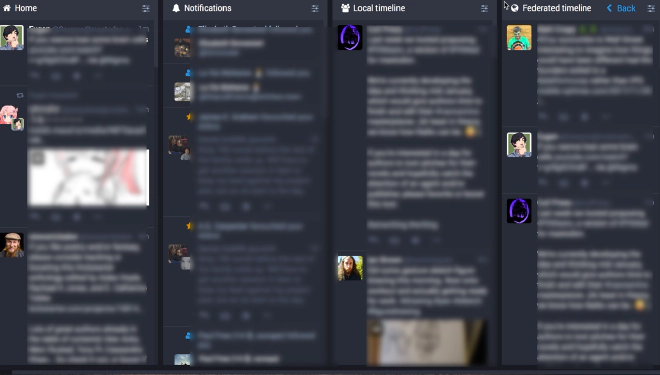Reader, I did it again. I joined another social network.
I know, I know. I should know better, right? But this time feels different. There’s something special about this one. Maybe it’s simply the contrast from Facebook and Twitter that makes it so appealing, but I can’t help but feel there is great promise in Mastodon.
I had heard of it earlier of course. There was a lot of press about it in April of this year, but I couldn’t imagine myself migrating from Twitter. Especially since a huge part of the reason that I use the bird site is to follow “Writer Twitter”,1 particularly the SFF crowd. However, with all the issues with harassment and rampant Nazis on on the service, there was renewed interest in finding an alternative, and I saw several prominent authors hopping over to give it a try.
I figured, why not?
What is it? #

For those of you unacquainted with the service, Mastodon is a decentralized Twitter-like service. It’s goal is to provide a clean, easy-to-deploy implementation of GNU Social, an open source protocol for social networks, while adding a rich feature set aimed at addressing shortcomings in other services.
I can hear you now: What the hell does that mean?
It means that it’s a network that cannot be controlled by a single entity. It can be deployed across any number of independent servers that can all link together. In practice this means that a corporation cannot control it. You may ask, beside the OSS hippie stuff, why is this important?
Simply put, a corporation is negatively incentivized to permit outrageous behavior because it drives conflict, which in turn breeds lots of toxic and addictive engagement. Either Twitter is complicit in condoning abuse, or their inaction is due to the need to maintain engagement and growth, which in practice is indistinguishable from the former. It’s a corporation that has to serve the interests of its shareholders, not the community that uses it. Whereas in the decentralized framework, individual Mastodon instances can set more granular codes of conduct in alignment with their users. This approach can scale because there’s no need to try and host all the users in the same place. Spinning up new connected instances is relatively easy for a volunteer to do.2
In practice, this means each instance of Mastodon ends up with a little of its own flavor and culture. They’re linked together through the federated network but other instances don’t show up in your global feed unless someone on your server already follows them. Speaking of which, let’s talk about the feeds.

- Home: Posts from anyone you explicitly follow show up here.
- Notifications: Exactly what you expect.
- Local: Posts from your local instance show up here (minus any replies or blocked/muted users).
- Federated: All local posts and any posts by remote users that are followed by someone on your server show up here (minus any replies or blocked/muted users).
A significant portion of Mastodon’s growth seems to happening outside of the U.S., which is great for getting a world perspective, but can also make the Federated timeline a little inscrutable unless you know a lot of languages. As a result, Mastodon has preference settings so that you can filter out posts in languages that you don’t know how to read.
Mastodon has its own terminology as well, which may take a little getting used to coming from a different bird-oriented network. Retweets are called “Boosts” and Likes are called “Favorites”.3 Individual posts have the horrible, but fun, name of “Toots”.4 You can use the web app if you like, or any number of other apps to connect to it.5
Content warnings: a feature worth its own header #
Oh man, how I love this feature, and way more than I thought I would.
For any post you make, you can choose to prepend a content warning, or CW, to your message. This content warning will appear in the timeline over a “Show More” button, which can be used to reveal the content or not. This allows users to post things that are NSFW or should provide a trigger warning without worrying that they may truly upset someone.
At first, I didn’t think much of this, because while I’m a supporter of trigger warnings, I don’t personally have any triggers to manage. However, the community has evolved its usage of CWs to a wide variety of other cases. People will often post CWs for controversial topics like politics, negative rants, and really specialized areas of interest, allowing people following or in the timeline to simply skip over them if they don’t feel like having their blood pressure spike. Some are even using it to hide the punchlines of jokes to comedic effect.
But what about abuse? #
This is one area where Mastodon’s system makes a big difference. In addition to per-user mute and block options, Mastodon provides some powerful tools for admins. If users begin misbehaving, there are robust abuse reporting systems built into the platform, and with smaller, interconnected communities it is much easier for moderators and community managers to monitor, silence, or ban users if it is required. In a way, it’s not that dissimilar to a BBS from the dawn time of the internet, except that they all connect to each other.
Of course, since every community can set their own guidelines, what happens when the assholes show up? For example, let’s say the Nazis currently hanging out on Twitter decide to start their own instance and swarm harass everyone else. There’s tools for that as well. An admin can block that instance from theirs, or individual users can do the same for their own accounts. It doesn’t stop the bad apples from using the network, but can isolate and contain them.
What’s the business model? #
I see you there, my fellow jaded internet nomad. We’ve both been hurt before. We’ve learned the hard way that if you don’t have to pay for the product, you are the product, to be sold to advertisers and special interest groups. Hell, there are some that think formalizing that relationship would be a good thing. Others may have a more visceral reaction to the idea.
Remember App.net? I loved that service. You paid for an account, and other developers built great apps on top of the API. It was a cool, engaged community, but it didn’t scale out well because the price tag kept new people away, and it was centralized. It didn’t pan out, and folded.
It’s wise to ask for Mastodon’s answer to this question, to which it says, “there isn’t one.” Mastodon is an open source project of passion, and isn’t intended to ever be a business. While there are some large instances managed by the core group of developers, e.g. mastodon.social and octodon.social, most instances are smaller setups run by volunteers. Some pay out of pocket, but many more fund their hosting costs through Patreon.
I love this. Patreon is an amazing tool for funding artists, and I think it’s wonderful to take the same approach to chip in for hosting costs for a community that you love.
What about impersonation? #
This is a big deal for public figures, who have come to rely on Twitter’s verified checkmark to distinguish them from impersonators. They don’t want to have to worry about some jerk pretending to be them to either harass their fans or try to create controversy in their name. It happens. It’s shitty.
Mastodon doesn’t have a good answer to this, because its biggest asset, being decentralized, means that there is not an authority in the overall network that can issue that kind of verification. Mastodon usernames are similar to email addresses, and you could in theory have as many of them as you want. If you want to establish a canonical account for people to follow, you’ll need to prove it via another site, such as linking from your personal website, or with another authoritative account elsewhere.
Where am I? #
Personally, after looking around a bit, I’ve settled on the Wandering Shop for my instance. It’s targeted towards SFF writers and readers, has a great Code of Conduct, and a friendly community. I encourage you to spend some time looking around at different instances to find the one that’s right for you. Remember, you can follow and interact with people on any instance, so it doesn’t matter where your friends happen to be. It’s more about the kinds of people, and rules of discourse you want to have in your local timeline. Also, since your fellow users’ choices in follows builds the federated timeline, the instance you choose also serves as a lens through which you see the Mastodon network at large. The right instance can make a big difference, so check out their public timelines before diving in to get a feel for where you want to be. If you choose poorly, you can always move to another server via export/import.
I’m excited about Mastodon, which is something I didn’t think was possible for me anymore when it comes to social networks. I haven’t been this enthused about a platform since the early days of App.net, or even the early days of Twitter. What the future holds is unknown. Perhaps admins will get burned out, or growth will put the moderation tools to the test. It may not be here in a year, but for now, I’m having fun on a social network again, and I think that’s worth the risk.
You can find me on Mastodon as @andrlik@wandering.shop. I hope to see you there, no matter which instance you choose.
